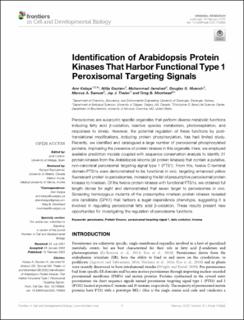| dc.contributor.author | Kataya, Amr Ramzy Abass | |
| dc.contributor.author | Gautam, Nitija | |
| dc.contributor.author | Jamshed, Muhammad | |
| dc.contributor.author | Muench, Douglas G. | |
| dc.contributor.author | Samuel, Marcus A. | |
| dc.contributor.author | Thelen, Jay J. | |
| dc.contributor.author | Moorhead, Greg B. | |
| dc.date.accessioned | 2023-01-19T09:03:25Z | |
| dc.date.available | 2023-01-19T09:03:25Z | |
| dc.date.created | 2022-05-31T11:00:21Z | |
| dc.date.issued | 2022 | |
| dc.identifier.citation | Kataya, A., Gautam, N., Jamshed, M., Muench, D. G., Samuel, M. A., Thelen, J. J., & Moorhead, G. B. (2022). Identification of Arabidopsis Protein Kinases That Harbor Functional Type 1 Peroxisomal Targeting Signals. Frontiers in cell and developmental biology, 10, 745883-745883. | en_US |
| dc.identifier.issn | 2296-634X | |
| dc.identifier.uri | https://hdl.handle.net/11250/3044486 | |
| dc.description.abstract | Peroxisomes are eukaryotic specific organelles that perform diverse metabolic functions including fatty acid β-oxidation, reactive species metabolism, photorespiration, and responses to stress. However, the potential regulation of these functions by post-translational modifications, including protein phosphorylation, has had limited study. Recently, we identified and catalogued a large number of peroxisomal phosphorylated proteins, implicating the presence of protein kinases in this organelle. Here, we employed available prediction models coupled with sequence conservation analysis to identify 31 protein kinases from the Arabidopsis kinome (all protein kinases) that contain a putative, non-canonical peroxisomal targeting signal type 1 (PTS1). From this, twelve C-terminal domain-PTS1s were demonstrated to be functional in vivo, targeting enhanced yellow fluorescent protein to peroxisomes, increasing the list of presumptive peroxisomal protein kinases to nineteen. Of the twelve protein kinases with functional PTS1s, we obtained full length clones for eight and demonstrated that seven target to peroxisomes in vivo. Screening homozygous mutants of the presumptive nineteen protein kinases revealed one candidate (GPK1) that harbors a sugar-dependence phenotype, suggesting it is involved in regulating peroxisomal fatty acid β-oxidation. These results present new opportunities for investigating the regulation of peroxisome functions. | en_US |
| dc.language.iso | eng | en_US |
| dc.publisher | Frontiers Media | en_US |
| dc.rights | Navngivelse 4.0 Internasjonal | * |
| dc.rights.uri | http://creativecommons.org/licenses/by/4.0/deed.no | * |
| dc.title | Identification of Arabidopsis Protein Kinases That Harbor Functional Type 1 Peroxisomal Targeting Signals | en_US |
| dc.title.alternative | Identification of Arabidopsis Protein Kinases That Harbor Functional Type 1 Peroxisomal Targeting Signals | en_US |
| dc.type | Peer reviewed | en_US |
| dc.type | Journal article | en_US |
| dc.description.version | publishedVersion | en_US |
| dc.rights.holder | The author | en_US |
| dc.subject.nsi | VDP::Matematikk og Naturvitenskap: 400 | en_US |
| dc.source.volume | 10 | en_US |
| dc.source.journal | Frontiers in Cell and Developmental Biology | en_US |
| dc.identifier.doi | 10.3389/fcell.2022.745883 | |
| dc.identifier.cristin | 2028321 | |
| cristin.ispublished | true | |
| cristin.fulltext | original | |
| cristin.qualitycode | 1 | |

